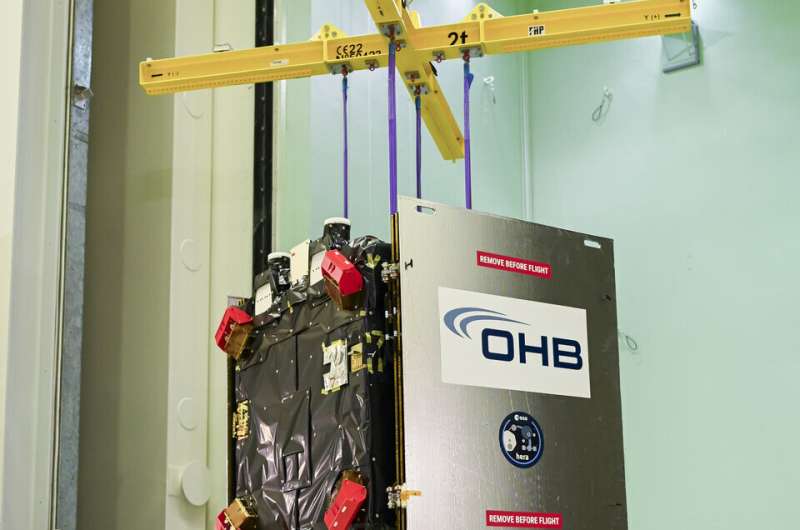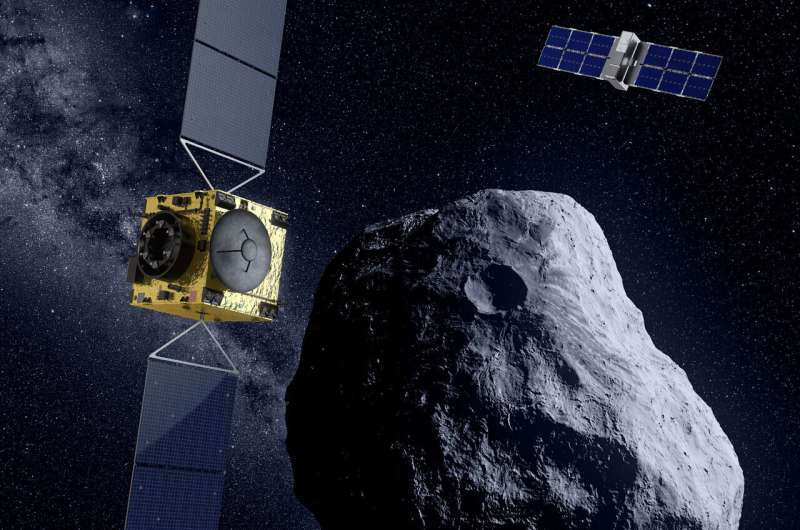This article has been reviewed according to Science X's editorial process and policies. Editors have highlighted the following attributes while ensuring the content's credibility:
fact-checked
trusted source
proofread
Hera asteroid mission completes acoustic testing

ESA's Hera asteroid mission has completed acoustic testing, confirming the spacecraft can withstand the sound of its own lift-off into orbit. Testing took place within the Agency's Large European Acoustic Facility at the ESTEC Test Center in the Netherlands. This is Europe's largest and most powerful sound system, fitted with a quartet of noise horns that can generate more than 154 decibels of extreme noise.
Diego Escorial Olmos, Hera system engineer comments, "Launch will be the single most stressful day of Hera's life, so we have worked hard to simulate it during our mechanical test phase, first by vibrating the spacecraft on the ESTEC Test Center's shaker tables, and now by blasting it with a noise profile sourced from our launch provider, to be as true to life as possible."
The LEAF chamber stands 11 m wide by 9 m deep and 16.4 m high. One of its walls is embedded with a set of enormous sound horns. Nitrogen shot through the horns can produce a range of noise up to more than 154 decibels, like standing close to multiple jets taking off at once.
As a safety feature, LEAF can operate only once its doors are closed. Steel-reinforced concrete walls safely contain its noise, which are also coated with epoxy resin to reflect noise to produce a uniform sound field within the chamber. The chamber itself is supported on rubber bearing pads to isolate it from its surroundings, preventing damage to the rest of the Test Center—or nearby human observers.
Hera was switched on for the test sessions, and placed in launch configuration, with its solar wings folded around its body and its fuel tanks filled with helium, nitrogen and water. Ahead of testing it had been fitted with more than 130 accelerometers to chart the forces exerted on it then ringed by microphones to record the surrounding noise levels, to ensure the tests attain their planned volume.
ESA structures engineer Simon Whent, supporting the design of the Hera spacecraft structure and many of its payloads, comments, "Even though this acoustic testing has been exhaustively modeled ahead of time, it was still a nerve-wracking moment as the giant doors of the LEAF chamber close and then the horns are activated. Each test session lasts for just a minute—but that still seemed like a very long time as we waited to find out if Hera's structure and components withstand the sound waves blasting it."
ESA mechanical systems and structures engineer Cliff Ashcroft, who led the design of Hera's central tube 'backbone," adds, "In reality, the highest, most damaging levels of acoustic pressure are felt during the early launch phase, generated at or close to lift-off, when the vibrations reflected from the pad and local facility bombard the departing launcher. It is a kind of final acoustic 'pat on the back' as the launcher and spacecraft depart from Earth."
Hera is Europe's contribution to an international planetary defense experiment. Following the DART mission's impact with the Dimorphos asteroid last year—modifying its orbit and sending a plume of debris thousands of kilometers out into space—Hera will return to Dimorphos to perform a close-up survey of the crater left by DART. The mission will also measure Dimorphos' mass and make-up, along with that of the larger Didymos asteroid that Dimorphos orbits around.

Hera is scheduled for launch in October 2024, to rendezvous with the Didymos and Dimorphos asteroid system about two years later.
"The successful completion of Hera's mechanical test phase sets us well on track to meet that deadline, thanks to the collective dedication of ESA's Hera team, prime contractor OHB and European Test Services, managing the Test Center for ESA," comments Paolo Martino, leading the mission engineering team.
"The remainder of this year will see the spacecraft undergoing various functional tests and preparation for its next important testing milestone—sustained operation in space-grade vacuum and temperature extremes within a thermal vacuum chamber, scheduled for early next year, followed by testing of the inter-satellite links that will keep Hera connected to the pair of CubeSats it will deploy in the vicinity of Dimorphos."
Provided by European Space Agency


















